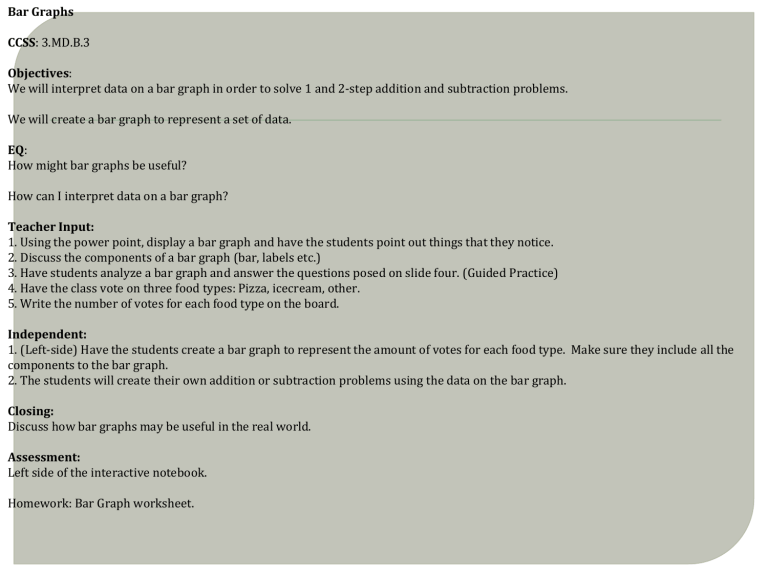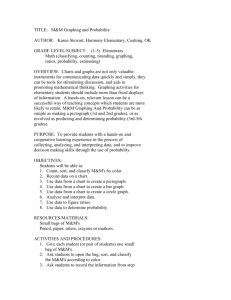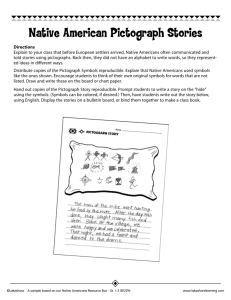File

Bar Graphs
CCSS: 3.MD.B.3
Objectives:
We will interpret data on a bar graph in order to solve 1 and 2-step addition and subtraction problems.
We will create a bar graph to represent a set of data.
EQ:
How might bar graphs be useful?
How can I interpret data on a bar graph?
Teacher Input:
1. Using the power point, display a bar graph and have the students point out things that they notice.
2. Discuss the components of a bar graph (bar, labels etc.)
3. Have students analyze a bar graph and answer the questions posed on slide four. (Guided Practice)
4. Have the class vote on three food types: Pizza, icecream, other.
5. Write the number of votes for each food type on the board.
Independent:
1. (Left-side) Have the students create a bar graph to represent the amount of votes for each food type. Make sure they include all the components to the bar graph.
2. The students will create their own addition or subtraction problems using the data on the bar graph.
Closing:
Discuss how bar graphs may be useful in the real world.
Assessment:
Left side of the interactive notebook.
Homework: Bar Graph worksheet.
Bar Graphs
Objectives:
We will interpret data on a bar graph in order to solve 1 and
2-step addition and subtraction problems.
We will create a bar graph to represent a set of data.
EQ:
How might bar graphs be useful?
How can I interpret data on a bar graph?
What do you notice?
Components to a Bar Graph
Scale (dependent variable)
Title of the Bar
Graph
Bar
Categories
(independent variable)
Labels
Analyze the Data
1. How many students like hip hop?
2. How many students like rock?
3. How many more students like jazz than classical?
4. If Paramore (a rock band) and Jay-Z
(a hip hop rapper) made a song together called Mr. H and the 19 misfits, how many more students are likely to listen to that song than a Jazz song?
What kind of food you like?
⦿
Pizza?
⦿
Ice cream?
⦿
Other?
⦿
Using these data, create a bar graph on the left side of your interactive notebook. Then, create 2 addition or subtraction problems to go with the bar graph.
PictoGraphs
CCSS: 3.MD.3
Draw a scaled picture graph and a scaled bar graph to represent a data set with several categories. Solve one- and two-step
“how many more” and “how many less” problems using information presented in scaled bar graphs. For example, draw a bar graph in
which each square in the bar graph might represent 5 pets.
SFO:
-I can read and analyze pictographs.
-I can create a pictograph to represent a given set of data.
Essential Questions:
-What is a pictograph?
-What is the difference between a pictograph and a bar graph?
-Why do we use pictographs?
-How can I read and interpret a pictograph?
Teacher Input:
-Slide 1: Introduce pictographs using Power Point. Go over the lessons objectives with the students.
-Slide 2: Ask students to look at the pictograph and tell what they notice
-Slide 3: Discuss the important components of a pictograph: title, symbols, labels, key
-Slide 4: Guided Practice: Display a pictograph and have students read and analyze it by answering questions.
-Slide 5: Independent Practice: Collect a class set of data. For example: favorite football team, favorite candy, favorite food, favorite subject etc. Collect the data and have students record on the left side of their notebook. Tell students that they will then create a pictograph using the class set of data. Tell them to make sure they include a title, symbols, label, and key. Tell students to create 3 questions to go with their pictograph. Give students 2 two-step questions to answer based on the data.
Closing: Discuss what they learned about bar graphs from yesterday and pictographs today and discuss the differences in both graphs.
Assessment: Left side of interactive notebook
Pictographs
Objective(s):
-I can understand and identify the parts that make up a pictograph.
-I can read and understand a pictograph by correctly answering questions
-I can create my own pictograph after collecting a set of data.
A graph that uses symbols to represent data.
What do you notice about these pictographs?
Parts of a pictograph graph
Title – Every pictograph should have a title that fits the data.
Symbols - Pictographs have symbols or pictures to represent the data.
Key – Pictographs have a key to show what each symbol/picture represents. Be careful because not every picture/symbol represents 1!
Labels – Pictographs have labels for their pictures or symbols
It is very important to look at the key and determine how many pieces each symbol represents.
It is very important to remember the symbol in the key represents multiple pieces. If the data does not match the number of the symbol, the symbol must be cut to represent the fraction of the piece.
Cardinal
Dove
Crow
Blue Jay
Since each represents 2 birds, the half bird would represent one. There were 3
Cardinals, and 9 Crows.
= 2 birds
Guided Practice
Read and
Interpret the
Pictograph
•In January
_______ apples were sold
•How many more were sold in
February than in
April?
__________
Guided Practice
1. How many members were part of the chess club?
________
2. How many more students were in the math club than the
Hobby club?
_______
Left Side: Assessment
Create a survey question to ask the class. Examples are favorite NFL football team, favorite ice cream flavor, favorite subject in school, favorite sport. We will record the data as a class and you will create a pictograph representing the data. You will then answer 4 of my questions and create one of your own about your pictograph. Remember your pictograph must include:
-Title
-Symbols (must represent your data)
-Labels
-Key
Line Plots
CCSS: 3.MD.B.4
Objectives:
We will interpret data on a line plot.
We will create a line plot to represent a set of data.
EQ:
How might line plots be useful?
How can I interpret data on a line plot?
Teacher Input:
1. Using the power point, display a line plot and have the students point out things that they notice.
2. Discuss the components of a line plot.
3. Have students analyze a line plot and answer the questions posed on slide four. (Guided Practice)
4. Collect a class set of data.
5. Write down the data on the board.
Independent:
1. (Left-side) Have the students create a line plot to represent the amount of votes for each food type. Make sure they include all the components to the line plot.
Closing:
Discuss how line plots may be useful in the real world.
Assessment:
Left side of the interactive notebook.
Homework: Lineplot worksheet.
Line Plots
Objectives:
We will interpret data on a line plot.
We will create a line plot to represent a set of data.
EQ:
How might line plots be useful?
How can I interpret data on a line plot?
What do you notice?
Components to a Line Plot
Line plot--is a number line that represents data that is recorded in experiments or surveys. A line plot uses x or other marks to show frequency. It collects and classifies the data very quickly.
Title
Labels
X---represents one number in the data
Scale —may show a range of numbers or categories. A range shows from the minimum value to the maximum value.
Be Careful of the Key!
Sometimes, the x can represent more than just one!
For instance, on this line plot, you might say that 2 students have 8 candy bars.
However, in this line plot, the key explains that x = 2. In this line plot, how many students have 8 candy bars?
X = 2
Analyze the Data
1. How many students have 5 candy bars?
2. How many more students are there that have 5 candy bars than students with 3 candy bars?
3. How many students have 8 candy bars?
4. How many candy bars do they have total? How many more candy bars would they need in order to have 132 total?
X = 2
Left Side: Independent Practice
⦿
Using this menu, create a line plot that shows how many food items fall within the following price ranges:
$0 – $0.99
$1.00 – $1.99
$2.00 - $2.99
$3.00 - $3.99
$4.00 - $4.99
$5.00 or more
⦿
Then, create 2 addition or subtraction problems to go with the bar graph.
Paideai Seminar “Graphic Ice Cream” using Jacob’s Ladder passage
CCSS: CCSS: 3.MD.3
Draw a scaled picture graph and a scaled bar graph to represent a data set with several categories. Solve one- and two-step “how many more” and “how many less” problems using information presented in scaled bar graphs. For example, draw a bar
graph in which each square in the bar graph might represent 5 pets.
SFO:
-I can share my opinion by using evidence from a text by participating in a Paideai seminar.
Teacher Input:
-Give students “Graphic Ice Cream” passage from Jacob’s Ladder. Have students read independently.
-Put students facing each other in a circle.
-Make sure to develop some type of system to where kids can keep track of how many times they speak such as tallies every time they talk
-Begin by review the expectations during a Paideai seminar. (ie. listen when other are talking, use scholarly language, use the text to support your answer, respect other’s opinions)
-Begin by asking the students a question with a one word answer such as: What is one word that comes to mind when you think of graphing?
1. Why do we collect and represent data using graphs?
2. Why did the author title the selection “Graphic Ice Cream?” Use evidence from the text to support your answer.
3. How would you characterize the owners of Crema? Use details from the text to support your answer.
4. Can you give a generalization about using graphs to represent data?
5. What are different kinds of data that are often gathered or could be gathered?
6. What job professions in the real world do you think use graphs to represent data?
-End the seminar with another one word question such as: If you were to create a different title for this selection, what would it be?
Closing: -At the end of the seminar have the students complete the Paideai seminar rubric and grade themselves as to how you think they did.
Assesssment: Paidaei Seminar Rubric or have students answer the questions out of the Jacob’s Ladder passage
Assessment: Create a bar graph using Microsoft Excel
CCSS: CCSS: 3.MD.3
Draw a scaled picture graph and a scaled bar graph to represent a data set with several categories.
Solve one- and two-step “how many more” and “how many less” problems using information presented in scaled bar graphs. For
example, draw a bar graph in which each square in the bar graph might represent 5 pets.
SFO:
-I can conduct a survey in order to gather data.
-I can create a bar graph using to represent a given set of data given Microsoft Excel.
Teacher Input:
-Students’ survey results are due on Wednesday. Students will use their survey results to create a bar graph on Microsoft
Excel. Students have already learned and created a bar graph in technology. You might want to determine students who were good at Excel to help students if they get stuck while in the computer lab.
-You will want to sign up for a time in the computer lab using http://irwinbyot.weebly.com/ . You will want to click on sign-up central and then technology.
Assessment:
Bar graph on Microsoft Excel





